Fraud Detection Techniques Assignment - University Finance Module
VerifiedAdded on 2023/01/09
|6
|1120
|22
Homework Assignment
AI Summary
This assignment delves into various aspects of fraud detection techniques within a finance context. It begins with short answer questions exploring fraud risk factors, control mechanisms against corruption, benefits of analytic procedures in audits, rationalizations for fraudsters, and important points for evaluating fraud risk. The assignment then discusses circumstances that enable fraud, focusing on management's role. It further explores the types of questions an auditor should ask management to identify fraud risks, as suggested by SAS 99. A case study on a fraud investigation report is included, prompting analysis of the type of evidence an expert would gather and the documents that would assist the forensic expert. The assignment concludes with a reference list of relevant academic sources.
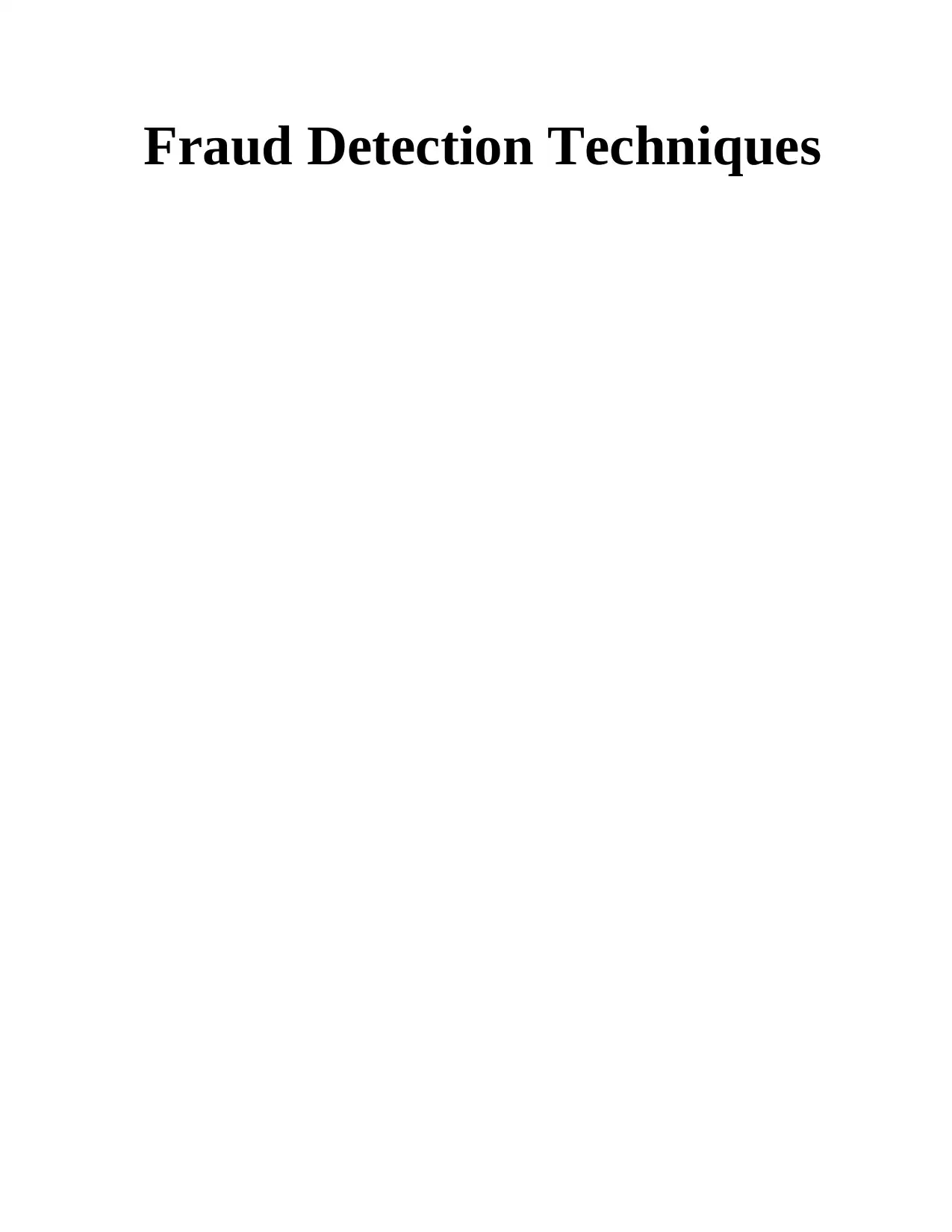
Fraud Detection Techniques
Paraphrase This Document
Need a fresh take? Get an instant paraphrase of this document with our AI Paraphraser
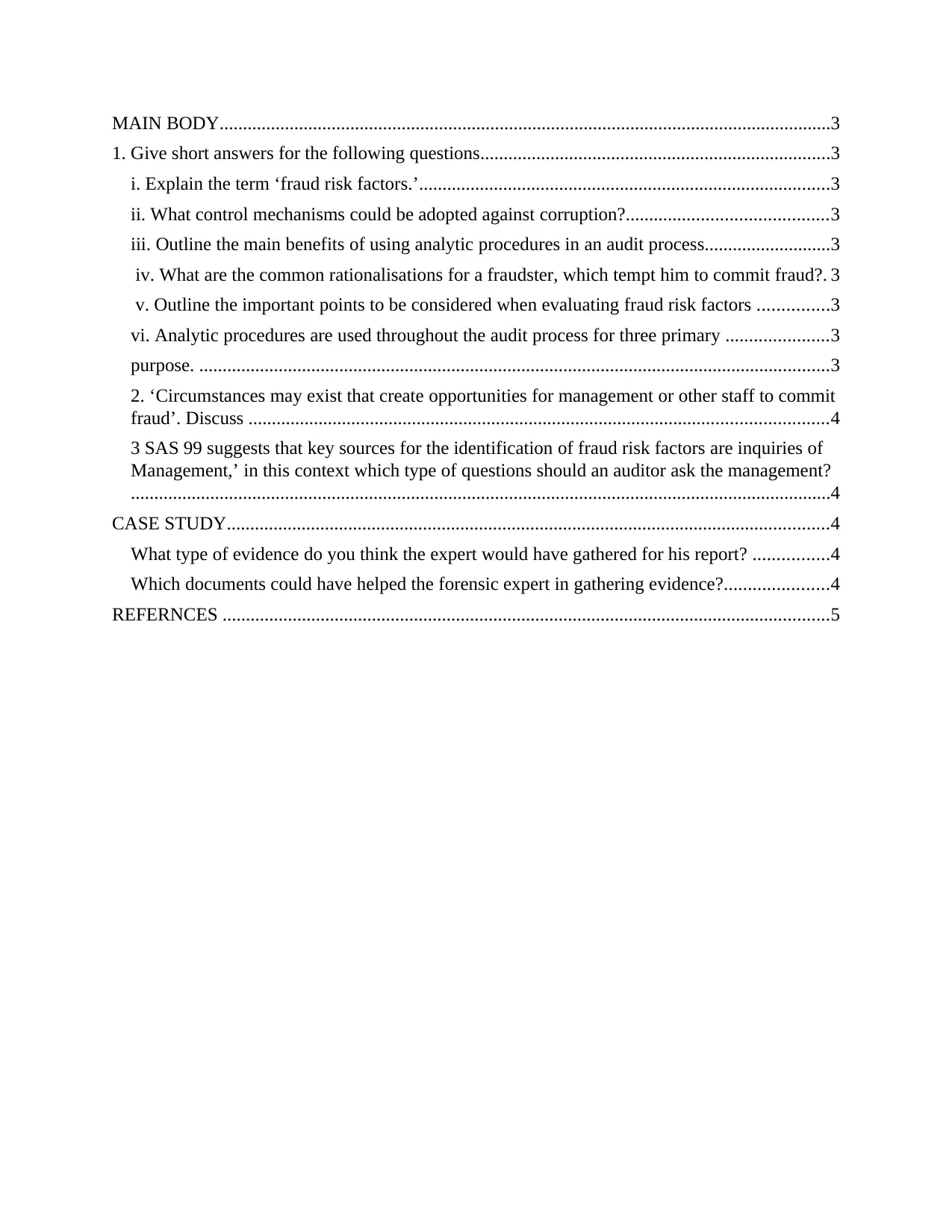
MAIN BODY...................................................................................................................................3
1. Give short answers for the following questions...........................................................................3
i. Explain the term ‘fraud risk factors.’........................................................................................3
ii. What control mechanisms could be adopted against corruption?...........................................3
iii. Outline the main benefits of using analytic procedures in an audit process...........................3
iv. What are the common rationalisations for a fraudster, which tempt him to commit fraud?. 3
v. Outline the important points to be considered when evaluating fraud risk factors ...............3
vi. Analytic procedures are used throughout the audit process for three primary ......................3
purpose. .......................................................................................................................................3
2. ‘Circumstances may exist that create opportunities for management or other staff to commit
fraud’. Discuss ............................................................................................................................4
3 SAS 99 suggests that key sources for the identification of fraud risk factors are inquiries of
Management,’ in this context which type of questions should an auditor ask the management?
......................................................................................................................................................4
CASE STUDY.................................................................................................................................4
What type of evidence do you think the expert would have gathered for his report? ................4
Which documents could have helped the forensic expert in gathering evidence?......................4
REFERNCES ..................................................................................................................................5
1. Give short answers for the following questions...........................................................................3
i. Explain the term ‘fraud risk factors.’........................................................................................3
ii. What control mechanisms could be adopted against corruption?...........................................3
iii. Outline the main benefits of using analytic procedures in an audit process...........................3
iv. What are the common rationalisations for a fraudster, which tempt him to commit fraud?. 3
v. Outline the important points to be considered when evaluating fraud risk factors ...............3
vi. Analytic procedures are used throughout the audit process for three primary ......................3
purpose. .......................................................................................................................................3
2. ‘Circumstances may exist that create opportunities for management or other staff to commit
fraud’. Discuss ............................................................................................................................4
3 SAS 99 suggests that key sources for the identification of fraud risk factors are inquiries of
Management,’ in this context which type of questions should an auditor ask the management?
......................................................................................................................................................4
CASE STUDY.................................................................................................................................4
What type of evidence do you think the expert would have gathered for his report? ................4
Which documents could have helped the forensic expert in gathering evidence?......................4
REFERNCES ..................................................................................................................................5
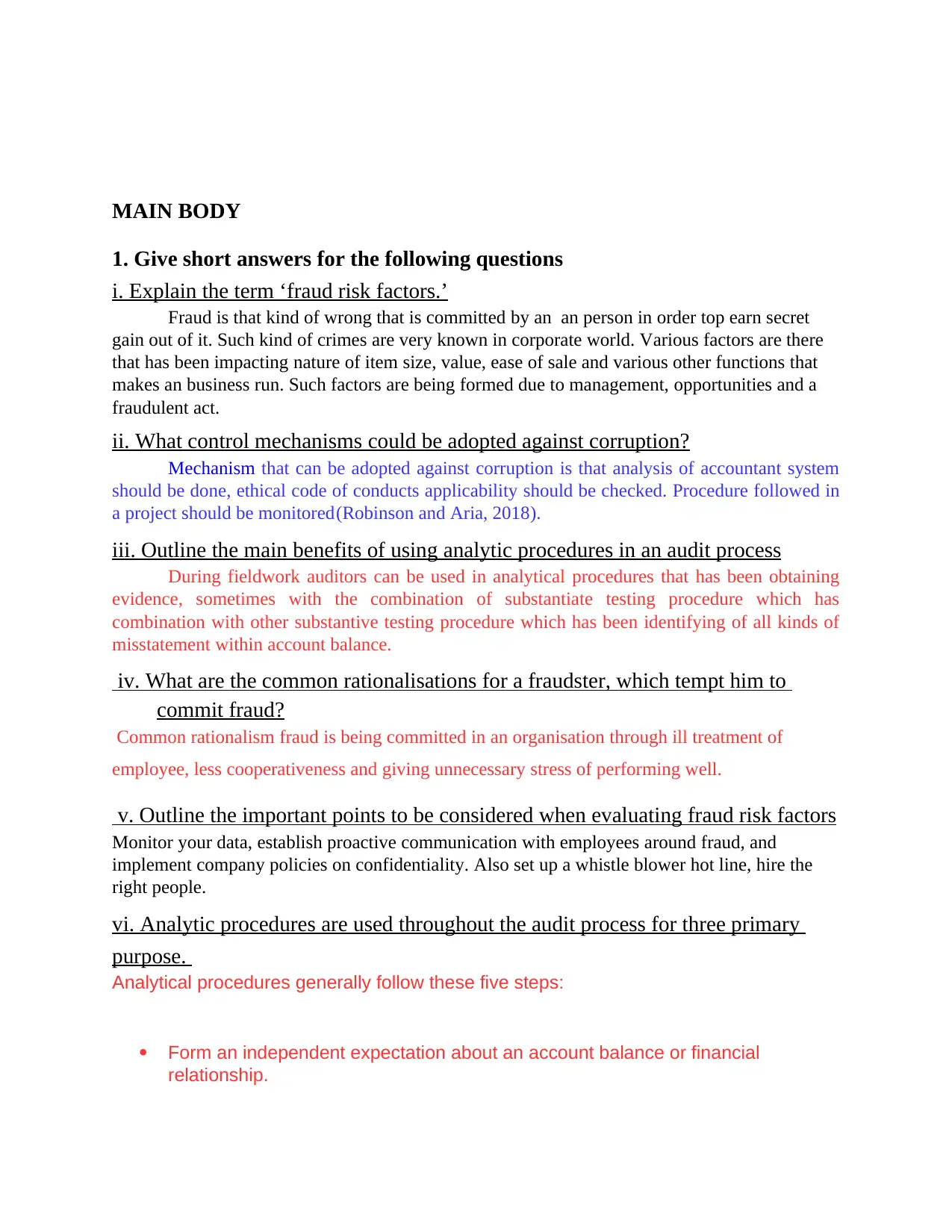
MAIN BODY
1. Give short answers for the following questions
i. Explain the term ‘fraud risk factors.’
Fraud is that kind of wrong that is committed by an an person in order top earn secret
gain out of it. Such kind of crimes are very known in corporate world. Various factors are there
that has been impacting nature of item size, value, ease of sale and various other functions that
makes an business run. Such factors are being formed due to management, opportunities and a
fraudulent act.
ii. What control mechanisms could be adopted against corruption?
Mechanism that can be adopted against corruption is that analysis of accountant system
should be done, ethical code of conducts applicability should be checked. Procedure followed in
a project should be monitored(Robinson and Aria, 2018).
iii. Outline the main benefits of using analytic procedures in an audit process
During fieldwork auditors can be used in analytical procedures that has been obtaining
evidence, sometimes with the combination of substantiate testing procedure which has
combination with other substantive testing procedure which has been identifying of all kinds of
misstatement within account balance.
iv. What are the common rationalisations for a fraudster, which tempt him to
commit fraud?
Common rationalism fraud is being committed in an organisation through ill treatment of
employee, less cooperativeness and giving unnecessary stress of performing well.
v. Outline the important points to be considered when evaluating fraud risk factors
Monitor your data, establish proactive communication with employees around fraud, and
implement company policies on confidentiality. Also set up a whistle blower hot line, hire the
right people.
vi. Analytic procedures are used throughout the audit process for three primary
purpose.
Analytical procedures generally follow these five steps:
Form an independent expectation about an account balance or financial
relationship.
1. Give short answers for the following questions
i. Explain the term ‘fraud risk factors.’
Fraud is that kind of wrong that is committed by an an person in order top earn secret
gain out of it. Such kind of crimes are very known in corporate world. Various factors are there
that has been impacting nature of item size, value, ease of sale and various other functions that
makes an business run. Such factors are being formed due to management, opportunities and a
fraudulent act.
ii. What control mechanisms could be adopted against corruption?
Mechanism that can be adopted against corruption is that analysis of accountant system
should be done, ethical code of conducts applicability should be checked. Procedure followed in
a project should be monitored(Robinson and Aria, 2018).
iii. Outline the main benefits of using analytic procedures in an audit process
During fieldwork auditors can be used in analytical procedures that has been obtaining
evidence, sometimes with the combination of substantiate testing procedure which has
combination with other substantive testing procedure which has been identifying of all kinds of
misstatement within account balance.
iv. What are the common rationalisations for a fraudster, which tempt him to
commit fraud?
Common rationalism fraud is being committed in an organisation through ill treatment of
employee, less cooperativeness and giving unnecessary stress of performing well.
v. Outline the important points to be considered when evaluating fraud risk factors
Monitor your data, establish proactive communication with employees around fraud, and
implement company policies on confidentiality. Also set up a whistle blower hot line, hire the
right people.
vi. Analytic procedures are used throughout the audit process for three primary
purpose.
Analytical procedures generally follow these five steps:
Form an independent expectation about an account balance or financial
relationship.
⊘ This is a preview!⊘
Do you want full access?
Subscribe today to unlock all pages.

Trusted by 1+ million students worldwide
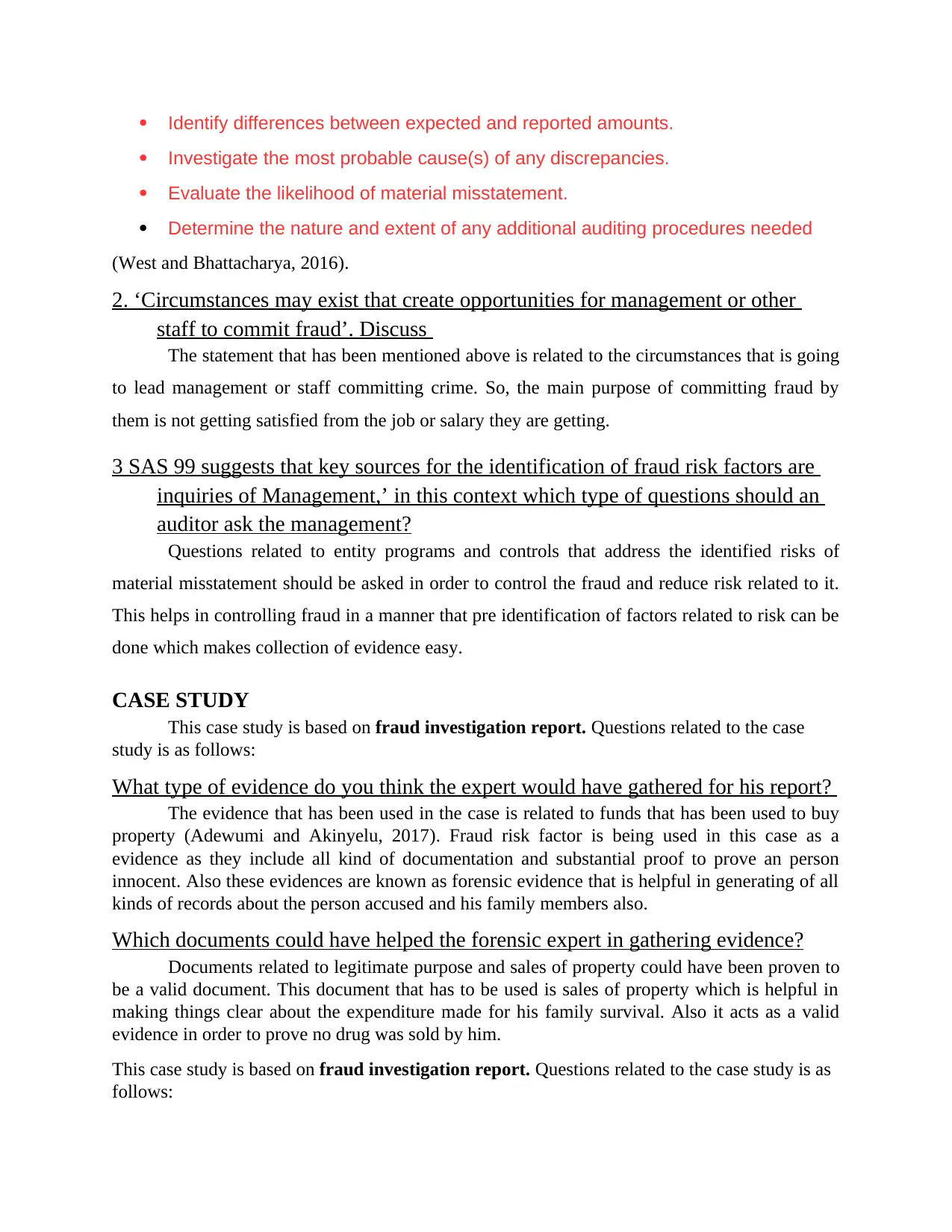
Identify differences between expected and reported amounts.
Investigate the most probable cause(s) of any discrepancies.
Evaluate the likelihood of material misstatement.
Determine the nature and extent of any additional auditing procedures needed
(West and Bhattacharya, 2016).
2. ‘Circumstances may exist that create opportunities for management or other
staff to commit fraud’. Discuss
The statement that has been mentioned above is related to the circumstances that is going
to lead management or staff committing crime. So, the main purpose of committing fraud by
them is not getting satisfied from the job or salary they are getting.
3 SAS 99 suggests that key sources for the identification of fraud risk factors are
inquiries of Management,’ in this context which type of questions should an
auditor ask the management?
Questions related to entity programs and controls that address the identified risks of
material misstatement should be asked in order to control the fraud and reduce risk related to it.
This helps in controlling fraud in a manner that pre identification of factors related to risk can be
done which makes collection of evidence easy.
CASE STUDY
This case study is based on fraud investigation report. Questions related to the case
study is as follows:
What type of evidence do you think the expert would have gathered for his report?
The evidence that has been used in the case is related to funds that has been used to buy
property (Adewumi and Akinyelu, 2017). Fraud risk factor is being used in this case as a
evidence as they include all kind of documentation and substantial proof to prove an person
innocent. Also these evidences are known as forensic evidence that is helpful in generating of all
kinds of records about the person accused and his family members also.
Which documents could have helped the forensic expert in gathering evidence?
Documents related to legitimate purpose and sales of property could have been proven to
be a valid document. This document that has to be used is sales of property which is helpful in
making things clear about the expenditure made for his family survival. Also it acts as a valid
evidence in order to prove no drug was sold by him.
This case study is based on fraud investigation report. Questions related to the case study is as
follows:
Investigate the most probable cause(s) of any discrepancies.
Evaluate the likelihood of material misstatement.
Determine the nature and extent of any additional auditing procedures needed
(West and Bhattacharya, 2016).
2. ‘Circumstances may exist that create opportunities for management or other
staff to commit fraud’. Discuss
The statement that has been mentioned above is related to the circumstances that is going
to lead management or staff committing crime. So, the main purpose of committing fraud by
them is not getting satisfied from the job or salary they are getting.
3 SAS 99 suggests that key sources for the identification of fraud risk factors are
inquiries of Management,’ in this context which type of questions should an
auditor ask the management?
Questions related to entity programs and controls that address the identified risks of
material misstatement should be asked in order to control the fraud and reduce risk related to it.
This helps in controlling fraud in a manner that pre identification of factors related to risk can be
done which makes collection of evidence easy.
CASE STUDY
This case study is based on fraud investigation report. Questions related to the case
study is as follows:
What type of evidence do you think the expert would have gathered for his report?
The evidence that has been used in the case is related to funds that has been used to buy
property (Adewumi and Akinyelu, 2017). Fraud risk factor is being used in this case as a
evidence as they include all kind of documentation and substantial proof to prove an person
innocent. Also these evidences are known as forensic evidence that is helpful in generating of all
kinds of records about the person accused and his family members also.
Which documents could have helped the forensic expert in gathering evidence?
Documents related to legitimate purpose and sales of property could have been proven to
be a valid document. This document that has to be used is sales of property which is helpful in
making things clear about the expenditure made for his family survival. Also it acts as a valid
evidence in order to prove no drug was sold by him.
This case study is based on fraud investigation report. Questions related to the case study is as
follows:
Paraphrase This Document
Need a fresh take? Get an instant paraphrase of this document with our AI Paraphraser

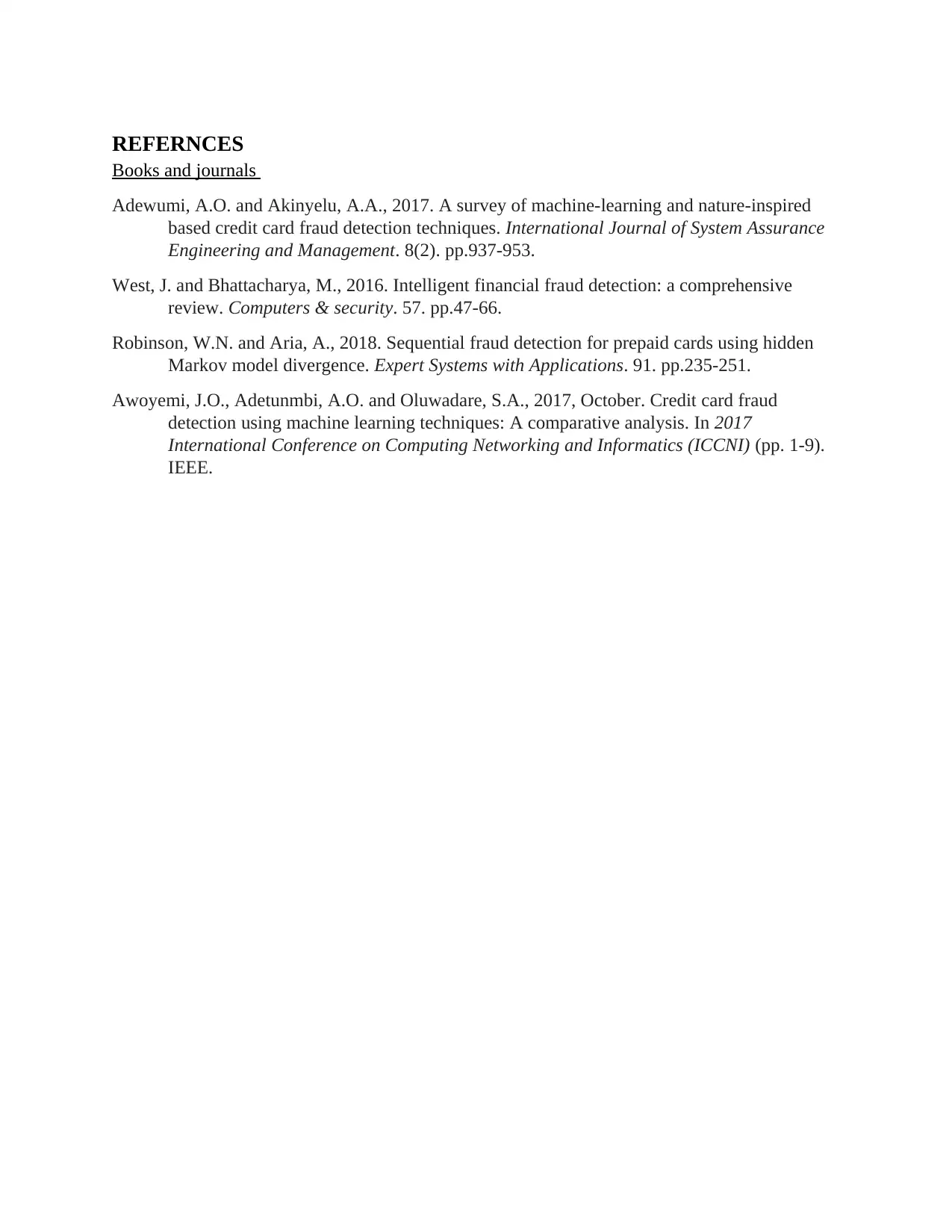
REFERNCES
Books and journals
Adewumi, A.O. and Akinyelu, A.A., 2017. A survey of machine-learning and nature-inspired
based credit card fraud detection techniques. International Journal of System Assurance
Engineering and Management. 8(2). pp.937-953.
West, J. and Bhattacharya, M., 2016. Intelligent financial fraud detection: a comprehensive
review. Computers & security. 57. pp.47-66.
Robinson, W.N. and Aria, A., 2018. Sequential fraud detection for prepaid cards using hidden
Markov model divergence. Expert Systems with Applications. 91. pp.235-251.
Awoyemi, J.O., Adetunmbi, A.O. and Oluwadare, S.A., 2017, October. Credit card fraud
detection using machine learning techniques: A comparative analysis. In 2017
International Conference on Computing Networking and Informatics (ICCNI) (pp. 1-9).
IEEE.
Books and journals
Adewumi, A.O. and Akinyelu, A.A., 2017. A survey of machine-learning and nature-inspired
based credit card fraud detection techniques. International Journal of System Assurance
Engineering and Management. 8(2). pp.937-953.
West, J. and Bhattacharya, M., 2016. Intelligent financial fraud detection: a comprehensive
review. Computers & security. 57. pp.47-66.
Robinson, W.N. and Aria, A., 2018. Sequential fraud detection for prepaid cards using hidden
Markov model divergence. Expert Systems with Applications. 91. pp.235-251.
Awoyemi, J.O., Adetunmbi, A.O. and Oluwadare, S.A., 2017, October. Credit card fraud
detection using machine learning techniques: A comparative analysis. In 2017
International Conference on Computing Networking and Informatics (ICCNI) (pp. 1-9).
IEEE.
⊘ This is a preview!⊘
Do you want full access?
Subscribe today to unlock all pages.

Trusted by 1+ million students worldwide
1 out of 6
Related Documents
Your All-in-One AI-Powered Toolkit for Academic Success.
+13062052269
info@desklib.com
Available 24*7 on WhatsApp / Email
![[object Object]](/_next/static/media/star-bottom.7253800d.svg)
Unlock your academic potential
Copyright © 2020–2025 A2Z Services. All Rights Reserved. Developed and managed by ZUCOL.





